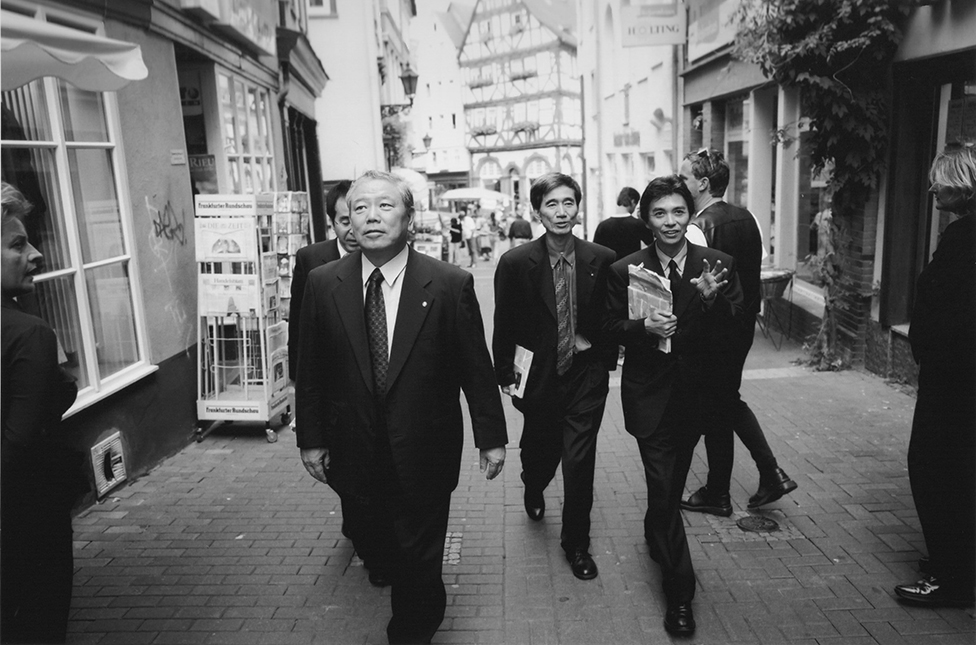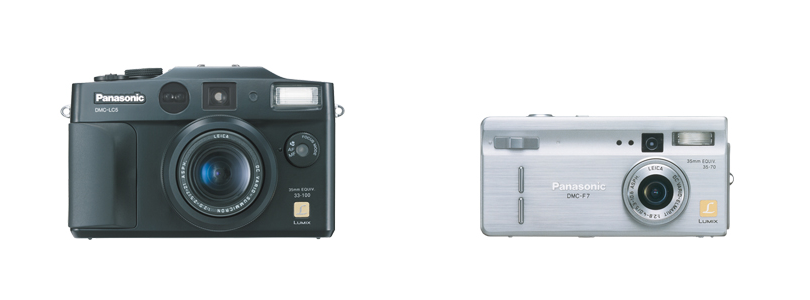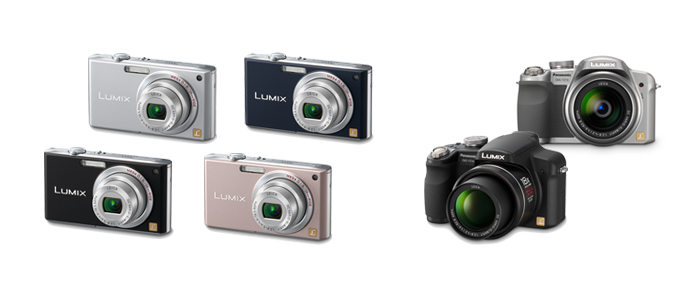 Chapter 2 : The Birth of LUMIX
Chapter 2 : The Birth of LUMIX
How the Brand Was Created Together with the Best Partner
In the mid-1990s, a shift from analog cameras to digital cameras began, spurring many manufacturers to launch into the digital camera market one after another. Our company was no exception. Our group companies such as Matsushita Electric Industrial Co., Ltd. (former name), Matsushita-Kotobuki Electronics Co., Ltd. (former name) and Kyushu-Matsushita Industrial Co., Ltd. (former name) started developing and commercializing digital still cameras independently. As a result, Panasonic’s technological and marketing resources became distributed, hindering smooth business activities.

Matsushita
Electric Industrial
Co., Ltd.
Card Shot
Matsushita-
Kotobuki
Electronics Co., Ltd.
COOLSHOT II
Kyushu-
Matsushita
Industrial Co., Ltd.
COOLSHOT
How did our company consolidate the digital camera products that had been developed independently under the unified brand name of “LUMIX”? How did we break into the market in spite of being a late comer? In this article, we will unravel the birth of the LUMIX brand, together with mentions of some behind-the-scene episodes.
Section 1: Why we chose Leica Camera AG as our collaboration partner
While the digital camera market was rapidly growing, Panasonic Group’s companywide project was ordered in October 2000 with the aim of making full-fledged inroads into the digital camera market with concerted efforts. Only one month later, the members of the group companies were summoned to the kick-off meeting, where they received a message from the president of the Matsushita Group (presently Panasonic Group). That was very unusual, so the attendees quickly realized the importance of the project.
Q What did Panasonic consider most necessary for the successful launch into the digital camera market?
The most important thing was to make LUMIX a trusted brand of cameras. To that end, we decided to seek collaboration of Leica, one of the most prestigious names in the industry trusted by professional photographers all over the world. Leica pursued the highest levels of quality without making compromises and released numerous legendary cameras and lenses. Together with this company, we set out to make LUMIX a top-class brand of digital cameras.
Q To start a collaboration with Leica, we had to obtain approval from their biggest shareholder who did not know much about our company. Which brand of ours do you think had great enough reputations to convince the shareholder?
The answer to that question is “Technics,” our audio product brand. Leica’s biggest shareholder at that time was a famous brand company. It was essential to obtain approval for the collaboration from that company. However, because our company name at that time, “Matsushita Electric,” was not well known in the shareholder’s local country, things didn’t go smoothly. So, we showed a Technics turntable during the presentation. The immediate response was: “Oh, your company makes Technics! I love my Technics products.” Approval for the collaboration was issued without any problem. That Technics was a brand loved all over the world was a joyful discovery for us, but this incident also made us realize how important the brand image was

Project members on the street of Wetzlar, the sacred home of Leica, where Oskar Barnack is said to have conducted his first photo tests. Photo provided by: Leica Camera AG
After overcoming many hardships, we concluded the collaboration agreement with Leica in 2001. Our press conference drew some 150 people even though its purpose was only to announce our collaboration with Leica and there was no product to show. The size of the crowd made us realize the great impact created by the collaboration of Leica and Panasonic

Section 2: How the name “LUMIX” was born
The brand name, LUMIX, is a coined word implying a fusion of “luminance” (optics) and digital technology. This was mentioned many times on many occasions. In the following, We will describe in vivid details the very moment the name LUMIX came into this world.
Q Which do you think was another strong candidate besides LUMIX?: 1. EPSILON or 2. KADOMAX
The answer is “both.” There were some 2,000 candidate names, but we found the names we liked, including EPSILON, were already registered as trademarks, so we were having difficulty in selecting the best name. Someone even suggested “KADOMAX,” which was Panasonic’s registered world trademark. Panasonic’s head office was indeed located in the city of Kadoma, but...
One day, the business manager at that time pulled out a piece of straw paper and scribbled a word hurriedly with the blue side of a red and blue pencil and said, “This is a word combining the Latin word, ‘lumi,’ and ‘digital.’” That word was “LUMIX.” This brand name laudably symbolized the fusion of optics and digital. The manager of the Planning Group at that time was also there and felt the name was perfect the moment he saw it. He was a designer and camera enthusiast. He recalled that all other candidate names became lost in oblivion.
His intuition proved right. The trademark research on “LUMIX” was conducted and we found that trademark issues could be cleared in almost all countries around the world except a few in which negotiations would be required. Thus, LUMIX became a registered world trademark of Panasonic.

Section 3: Keeping the first promise made with Leica
After the brand name was decided, we moved on to develop new products. To crown a lens with the prestigious name LEICA, we had to satisfy Leica’s stringent quality standards.
Q When finalizing the contract with Leica, how did Panasonic respond when Leica asked what Panasonic would do if Leica did not approve the quality of the lens design?
We said we would most certainly start over as many times as necessary. In fact, the first LUMIX camera was not approved easily. Leica’s examination and judgment were by far stricter than we had expected. Notwithstanding, we kept the initial promise with Leica and redid the design process until the required performance was attained, even if that meant postponing its market release. The profound relationship of trust that we were able to build based on such attitude remains to date.

LUMIX LC5
LUMIX F7
The scheduled announcement of the first LUMIX products, LC5 and F7, was delayed by one month, and the products were unveiled in October 2001, only one year after the companywide project was initiated. The camera bodies proudly carried the LUMIX emblems and the lenses were engraved with the name “LEICA.”
Section 4: Creating cameras for anyone to enjoy taking pictures
Q The following photos show a silver-halide camera and the FZ1, the second generation LUMIX, released in 2002 for comparison. Can you tell the feature common to both?

Here’s the answer: Both products had an F2.8 lens with a focal length of about 400 mm*. Achieving high zoom magnification with a silver-halide camera required a large, heavy and expensive zoom lens. In comparison, the FZ1 realized the 12x optical zoom with its compact body, thus creating a significant impact on the camera industry at that time. The TZ Series equipped with a high magnification lens that was released in 2006 sold extremely well as the Travel Zoom Series in the European market where the Panasonic brand was not familiar to the consumers.
*The silver halide SLR is 400mm and the FZ1 is 420mm.
We continued introducing new products one after another at the rates faster than industry trends in order to make up for the delay in launching into the digital camera market. The FX33/FX55 and FZ18 came equipped with the iA (Intelligent Auto) Mode, the world’s first* of its kind. It utilized automatic recognition to ensure beautiful pictures automatically according to shooting situations. This function has become common today. Cameras used to be a high-threshold hobby that required special knowledge. The iA function’s accomplishment of enabling anyone to take beautiful pictures easily is truly astounding.
*As of July 24, 2007. The shooting mode that suppresses blurring with the optical image stabilization/high sensitivity and motion recognition while automatically determines and sets the scene that matches the shooting situation based on the subject information.

At Panasonic, our engineers develop products based on the monozukuri (manufacturing) culture, “Always think for consumers and pursue the ease of use,” cultivated by the founder of Panasonic, Konosuke Matsushita. The camera that enabled anyone to take beautiful, blur-free telephoto pictures was indeed a concretization of Panasonic’s monozukuri spirit.
Ever since the brand was born, LUMIX has contributed to shaping “creating a new photo culture in the digital era with digital cameras” as our philosophy, while achieving technical breakthroughs and bringing easy enjoyment of photography to everyone. We, however, embraced the aspirations to make LUMIX a leading brand of cameras and to develop single-lens cameras someday.
That day came, and we eventually entered the single-lens camera market.
Continues to Chapter 3







